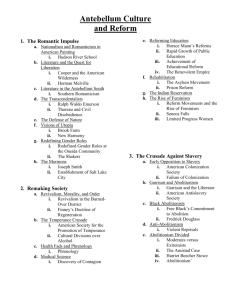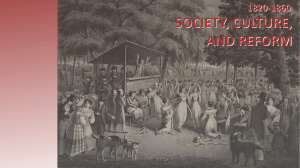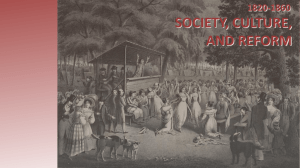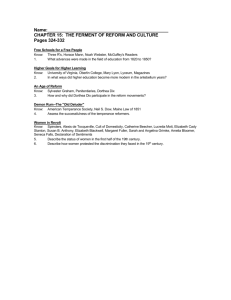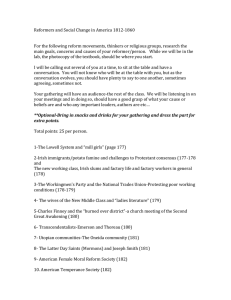The Industrialization of the North
advertisement
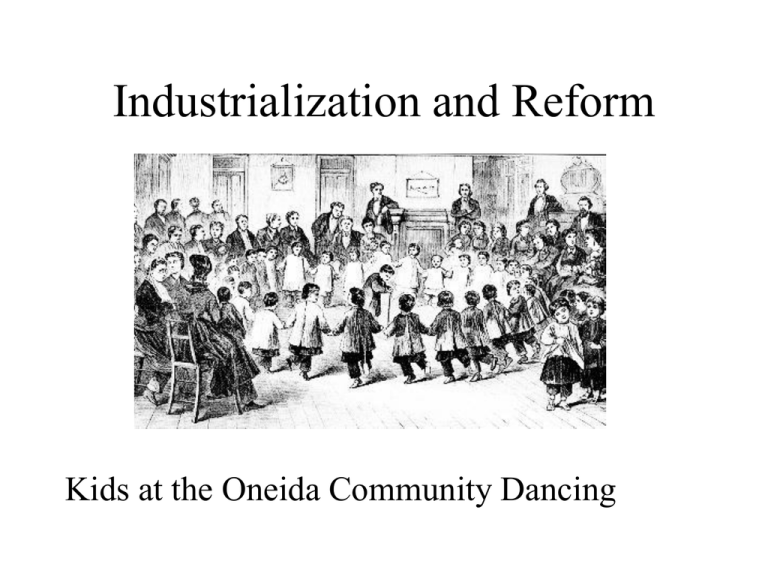
Industrialization and Reform Kids at the Oneida Community Dancing Economic Transformation • Agriculture to Manufacturing – 1820: 80% are farmers – 1850: 55% are farmers. Manufacturing = 1/3rd of all production • Rising Consumption Fuels Demand – Cash crop production pays for new goods – This demand motivates creating cheaper transportation • Roads • Canals • Trains The National Road The Transportation Revolution Begins (1825-40) • • Water transport is cheaper Canals boom 1825-40: 3000 miles – This begins in 1825 with the Erie Canal • • • Joint Public/Private venture 325 miles long 10 times cheaper transport! The Erie Canal (1825) Trains • • • • Invented for mines Requires iron boom 3000 miles by 1840 States aid rise of rail • Facilitates regional unity Political Support • Public/Private ventures fuel Transport Boom • Gibbons v. Ogden (1824) – – Overthrows a steamboat monopoly in NY Only Federal Government can regulate interstate transit and commerce! Urbanization: Big Picture • 1790 – 1 in 20 in 2,500 or more – Philadelphia: 40,000 • 1850 – 1 in 7 in 2,500 or more – 10 cities of 50,000+ – NYC = over 800,000 – Most cities in North Urbanization: Transport • Cities are too big to walk around now • New Urban Transport – omnibuses (horse-drawn) – steam ferries – commuter rail • City districts take on distinct purposes • Population outraces new housing, creating slums. City Types • Ports – NYC, Boston, Philadelphia, New Orleans • Interior Transport Hubs—Cleveland, Chicago, Saint Louis • Industrial Cities – New England – Immigrants dominate the population Immigration • Upheavals in Europe drive immigration of Germans and Irish • They compete with former artisans for city jobs. The Industrial Revolution Begins • Slavery and war drive enhanced wealth + demand for goods • Artisans can't keep up with demand • At first, farmers do part-time craft work • New machines begin to replace artisan labor – – Spinning Jenny (Thread) Mechanical Looms (Cloth) Labor Problems • How do you get factory workers? – – – Rhode Island System (farms + factory work) Waltham System (hire young women who need money and can't get married) The Irish (will do anything to avoid starving) The Cotton Gin • • • Eli Whitney invents it in 1793 Goal is to speed raw cotton processing Cotton production now BOOMS. The Steam Engine • • • Invented by James Watt in 1763-75 Enabled replacing muscle power with machine power Coal powered Replaceable Parts • • • Eli Whitney invents in early 1800s for guns Allows standard parts This eases repair and construction • Machines can make other machines! The Rise of Class: The Rise of Elites • Colonial Elites based on land – Strongly Rural • Industrial Elites based on owning means of industrial production – Strongly URBAN The Rise of Class: The Making of the Middle Class • Professionals, Small Businessmen, Middle Managers • Evangelical in Religion • They reject Alcohol consumption • Women are expected to stay home and raise kids (Cult of Domesticity) – They can afford to do this. The Working Classes • Those who must work for wages – – – Day labor on farms Factory workers Many are ex-Artisans, replaced by machines • They form the first unions • Often hostile to Immigrants Evangelical Reform • Fix society by eliminating sin! – – – • Keep the Sabbath holy (and not fun) Bible societies and Sunday Schools Eliminate Alcohol! Run by interlocking societies (The Benevolent Empire) Reverend Lyman Beecher • Congregationalist Preacher • Leader of the Sabbatarian movement Temperance Reform • • 1826: 7.1 gallons • of pure alcohol/adult/year! !! American Temperance Society is formed A Middle Class movement Temperance • Successes by 1851 • – – Many dry counties Down to 1.9 gallons/ adult/ year Failures – – Most Americans still drink a lot Angers Working Class Crusading Women • MC women go out to reform the world, despite gender rules of the time. • Auxillaries → founding their own groups • Rising Militancy – American Female Moral Reform Society • Many states ban adultery and abandonment Backlash Against Evanglical Reform • Catholics dislike it due to old feuds • WC resents bosses trying to control their homelife • Some men complain women have taken over the churches Joseph Smith • • • NY Farmer Claims to find a new revelation from God, the Book of Mormon Founds a new Religion Mormonism / The Church of Jesus Christ of Latter-Day Saints • Condemns other churches as evil • Male authority is supreme – Polygamy practiced by older men • They live communally • Heavily persecuted • They flee to Utah. The Enlightenment Impulse: School Reform • School Reform – – – – Starts in Massachusetts (1837) Six years of State-funded education for all Much more common in North than South By 1860, 50% of Whites are literate The Enlightenment Impulse: Places of Confinement • Goal: Micro-Society changes your bad behavior • Types – – – Prison (Criminals) Insane Asylum (Insane) Workhouse (Poor) • Limited success in goals due to bad design Utopians: The Shakers • Mystic Group Dancers • Celibate • Communal Property • 6000 at height • Economically Successful Utopians: The Oneida Community (1847-79) • John Noyes-Founder • Common Property • Group Marriage (everyone adult!) • Effort at Gender Equality Utopian Experiments: Socialism • New Harmony (1825-9) – Communal property and production – Lacked a central vision • Owen's vision of the town (the plan) Brook Farm • 1841-7 • Intellectuals try to farm due to delusions about nature • Ends in financial ruin due to bad management and fires The Colonization Movement • American Colonization Society – Voluntary Emancipation – 1,400 slaves sent to Liberia – Fades after 1830 Abolitionism • African-Americans are first to organize abolitionism • Appeal to the Colored Citizens of the World (1829) – Uses Declaration of Independence ideas, like equality of all men William Lloyd Garrison • • • A printer turned abolitionist after being put in jail Calls for immediate abolition! Inspires the Radical Abolitionists Organized Abolitionism • The American Anti-Slavery Society (1833) – – – – – White/Black Alliance Uses Evangelical Persuasion Methods Many are evangelicals Women play a huge role, like former slave owner Angelica Grimke Unable to persuade public by moral appeals alone Political Abolitionism • The Liberty Party (1840) – First Abolitionist PARTY. • “The Slave Power” – – Many come to fear South is out to cram slavery down everyone's throat They notice South has no free speech, mail is censored, etc. Women's Rights • • • • • Female Abolitionists found this 1848: Seneca Falls Convention Presses for right to vote and right to property By Civil War, many states allow women more property rights! (Right to vote: 1919)
